#international relations and rashomon
Explore tagged Tumblr posts
Text
What can IR students learn from the Movie "Rashomon"?
Let me tell you a story of Rashomon! Say a man – specifically a samurai – is killed in the woods in a seemingly remote village forest in Japan. One by one, each witness is brought before the court and told to narrate the story. First comes the woodcutter, who claims to have witnessed the horror of seeing the samurai’s dead body. Then comes a priest, who testifies against the likely attacker, a…

View On WordPress
#Adarsh Badri#akira kurasawa#between good and bad#international relations#international relations and rashomon#interpretation problem in international relations#IR students#japanese movie rashomon#movie rashomon#movies and IR#philosophical questions of rashomon#philosophy of rashomon#problem of autobiographical writings#rashomon effect#rashomon effect definition#rashomon movie#see through events#society#what rashomon teaches IR students
1 note
·
View note
Text
Prelims, Leverage
The top 2 results will move on to the main bracket
propaganda and summaries are under the cut (May include spoilers)
3.11 The Rashomon Job
Each member of the team recalls the story of an artifact all of them tried to steal on the same night five years ago.
its a great little bottle episode, if bottle episode meant something completely different than what it does. we get a sneak peak into everyone's histories, we get people making fun of each other by changing their stories once they realize oh my god that was YOU??? and we get shit like the Shrimp Allergy Debacle
3.15 & 3.16 The Big Bang Job & The San Lorenzo Job
The team infiltrates a Department of Defense research lab in order to stop Damien Moreau, the villain they have been working to catch all season, from murdering a brilliant engineer and auctioning her work off to international terrorists. / The team follows Moreau to San Lorenzo only to find that Moreau is the chief advisor to the current President. In order to take Moreau down, the team must first take over the country.
eliot fucking spencer
4.07 The Grave Danger Job
The team goes after a funeral home director who is scamming bereaved families out of their money but quickly discover the scam involves a Mexican drug cartel.
Hardisonnnnnnnnnnnn. This is one of my favorite episodes the tension is so real and it's also great for the crew as a whole.
5.15 The Long Good-Bye Job
Nate takes the team on one of its most dangerous missions, a con related to the death of his son.
10 notes
·
View notes
Text
Kurosawa's Critics: The Rejection Of His Homeland
Akira Kurosawa is considered to be a master of filmmaking by many, including filmmaker peers as outlined in previous blog posts. His works have influenced many western filmmakers and brought many eyes towards Japanese cinema on an international scale. From George Lucas’ Jedi stemming from the samurai his films to receiving remakes, Kurosawa had a major impact on the West. However, many believe that this is due to his “western” style of filmmaking standing apart from typical Japanese filmmakers. This topic of discussion typically comes up in relation to Kurosawa’s first major film: Rashomon.
youtube
Released in 1950, Rashomon followed a series of differing accounts on the same incident: the murder of a samurai and the raping of his wife. With its thought-provoking storytelling that meditates on the truth and subjectivity, this film would go on to be the first Japanese film to have won a major award at a western festival: the Golden Lion at Venice Film Festival in 1951. It’s believed that what helped the film most in its appeal at the festival was Kurosawa’s mixture of Western influences, such as the films of John Ford and Frank Capra. Due to this, many Japanese critics would then go on to accuse him of making films which pander to western audiences.

youtube
youtube
As noted by author Mitsuhiro Yoshimoto, “By many Japanese, Kurosawa is regarded as the most westernized Japanese director” (Yoshimoto, 2). Yet, it’s through his winning of the Golden Lion that is considered to have brought Japanese cinema to the global level, thus making Kurosawa one of the first major representatives of Japanese cinema to the world. However, this didn’t lighten any criticism from his fellow country men on the authenticity of his films to his homeland.

When interviewed by Donald Richie, Kurosawa had been discussing fellow Japanese filmmaker Mizoguchi and said, “People always say that [Mizoguchi’s] style is purely Japanese and mine is foreign. I don’t understand that” (Cardullo, 6). During this conversation he divulged into his differences with Mizoguchi and his films before saying, “Yet, of all Japanese directors, I like Mizoguchi best, and after him, Kinoshita. It might even be nostalgia- after all I am Japanese, and those two create a film which is purely Japanese.” With this thought, he returns to speaking on the critics, “But the Japanese critics go on and on about how Western I am. And mainly just because I do my own cutting and happen to prefer a fast tempo and am really interested in people” (Cardullo, 7).

Pictured: Kenji Mizoguchi
Here, Kurosawa expresses a distaste towards this critique, sensing it as an attack on his identity. With his statement, “after all I am Japanese” there’s this sense of disrespect felt by the director and how surely the concept of his cinema being ‘foreign’ never settled well with him.
Down the line, Kurosawa had then also been interviewed by Dan Yakir and claimed, “I don’t think I’m Western at all. I don’t understand how I could have that reputation… But it may be true that, as I was growing up, my education – like that of most people of my generation – compared to younger people today, covered a broader span: Shakespeare, Balzac, Russian literature. It’s quite natural that my education would manifest itself later in my work” (Cardullo, 74).

Within this 1980 interview, Kurosawa had to defend his films once again from the critique of being too “western” when Yakir had asked the director for his thoughts on that reoccurring opinion. Here, instead of expressing how Japanese he is, he instead opts to defend the evidence used against him: his western influences. Claiming his western influences to be more of a product of old-school Japanese upbringing, Kurosawa here then refutes the idea that he actively panders for western audiences.
Throughout his lifetime, Kurosawa would face the criticism time and time again of being too “western” of a Japanese filmmaker. One that, as seen here, has caused him to wrestle with his sense of identity. While considered by many in the west as an ambassador of Japanese filmmaking, in his own country he’s considered to be a foreigner. It’s that western viewpoint of respecting him as a Japanese filmmaker that makes this side of the filmmaker is seldom seen, but the tragedy of being seen as an outsider by much of his own countrymen is an aspect that should be given more thought. Despite having been a Japanese filmmaker who had dedicated much of his filmography to the culture and society of his homeland, he would be followed throughout his career by critics expressing that his works were too “foreign”. Meanwhile, the western opposition to this opinion which cemented him as a Japanese filmmaker thus made it so that even if Kurosawa had embraced being “western”, he wouldn’t even be accepted by the west. Kurosawa then is left in the limbo of being too “western” to be Japanese yet too Japanese to be “western”. Much like the crime in Rashomon, Kurosawa's westernization is left to the subjectivity of the people.
Sources:
Yoshimoto, Mitsuhiro. Kurosawa : Film Studies and Japanese Cinema. Duke University Press, 2000. EBSCOhost, search.ebscohost.com/login.aspx?direct=true&db=cat06985a&AN=bsu.190979&site=eds-live&scope=site.
Kurosawa, Akira, and Bert Cardullo. Akira Kurosawa : Interviews. University Press of Mississippi, 2008. EBSCOhost, search.ebscohost.com/login.aspx?direct=true&db=cat06985a&AN=bsu.242974&site=eds-live&scope=site.
0 notes
Text
Movie Mise-en-scène case analysis
I think MISE-EN-SCène is a very interesting place, which is the difference between pure composition. In a good composition, a picture can reflect a story in itself
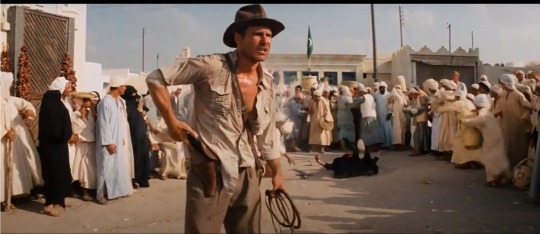
Take a classic lens in Indiana Jones, for example, a good picture can reflect a story
: Where is this person?
He is in the Arab region:
: What did this person do?
He killed someone:
: What do you use?
Use gun:
:Why?
It seems that the man wants to attack him:
: What attack?
Use a knife:
: What about the people around?
Some people are anxious, some people watch the show:
And this lens makes the light and shade relations very well. It is already a good Mise-en-scène.

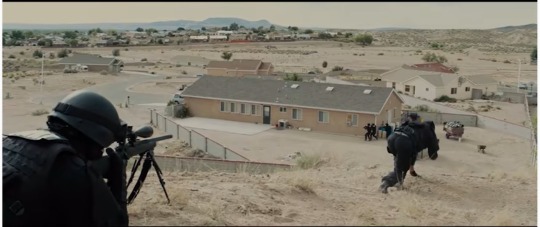
(There are many similar ones)
But I think this can only be said to be a good composition. Although the composition is good. But painting can also be done.

Then why you make movies? I think it is time, music and emotional changes. This is why the movie is a feast of Audio-Visua.
Rashomon
The lens of Woodcutter's walking in the forest, reflects the characters from the first situation, to the second lens to indicate the scene, what is the role of the next shot? What is the effect?
You can follow the lens to intuitively feel the depth of the forest, and the effects of landscape painting in China and Japan are also displayed. The silky switching of multi -perspectives gradually determines the protagonist, and then switched to the character's main perspective. Use the forest lens to present the mood.

Next, gradually switch the perspective to the side and back, and repeatedly alternate with the leaf's light and shade, and the characters shake in front of the camera. This makes the character's trembling and swaying mood.
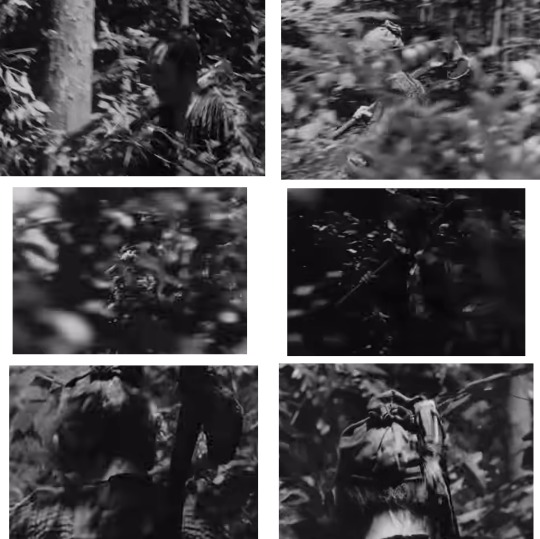
But here I want to make a difference with comics

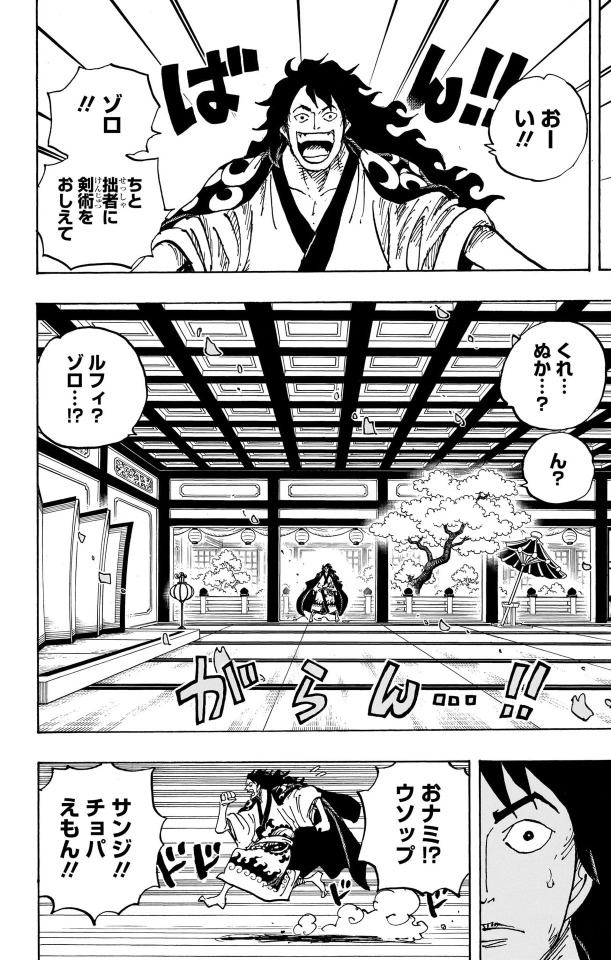

(ONE PIECE,Vol.105, 1056 C. )
In the picture, the characters interact with the scene, through the character's response to the scene (this is actually related to the Kuleshov-Effect), the lonely mood of the character is expressed, and under the repeated call of "general" and "general", the picture gradually cut out the picture out , A empty atmosphere spread. But the character suddenly switches the expression, and the changes in the character's response can show the meaning of the scene. That is, the character suddenly wants to enter a happy environment, but it is just empty. The reaction of the character at this moment has changed again, bringing anxious emotions. Between continuous scene switching, the internal space of the castle building with only one lens was observed, and the switching of the lens perspective expressed the "wrong" feelings. It was not until the character appeared and deepened before entering the next emotional stage.
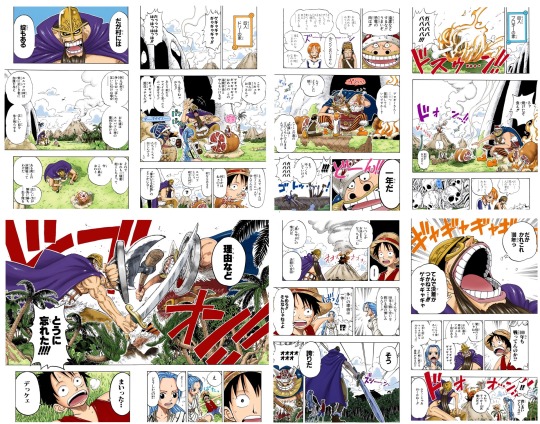
Just through the screen, the difference between the ratio of the movie and the comics is already a bit vague, but it is just the music change and timeline control of the lens in the movie "Rashomon". With a strong and eager relationship, pounds directly to the next scene.

(Vagabond,vol.12, page.34,35)
Lust, Caution,scene 1
Highlight the gloom of the character through the ductive way. But he showed a Republic of China soldier, and two officials by glory.

Determine the point of view by glowing to a character
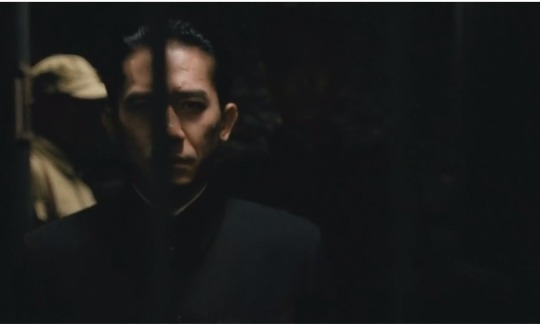
But once again to the supporting role
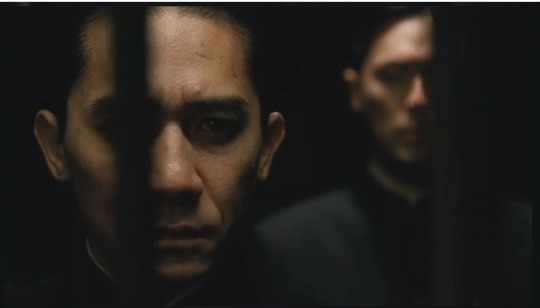
(Go into the cage)
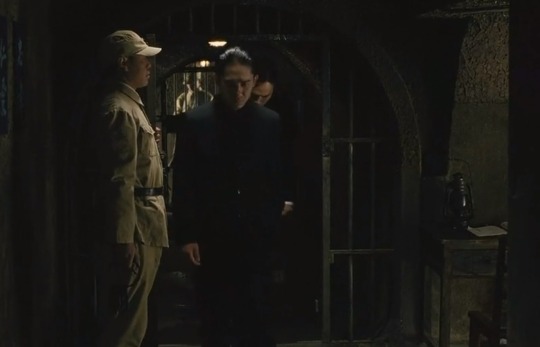
But with the dialogue, the two characters through multiple top lights on the top of the head make the light relationship change
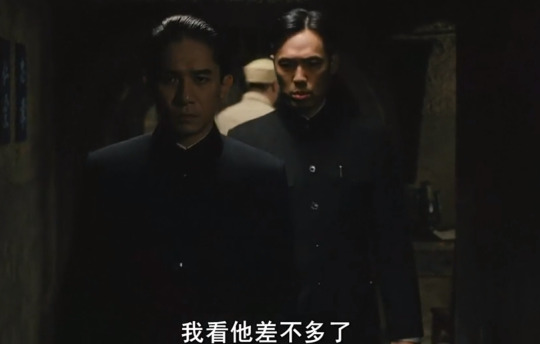
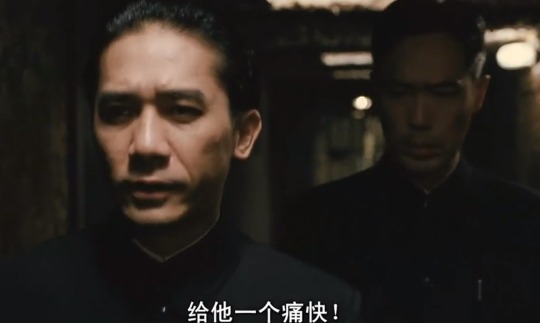
Until the original protagonist was completely backlight, the supporting role became larger and more light.

In fact, this paragraph is the passive role of the main character in front of the Japanese forces.
I feel very powerful in this paragraph. Because perfectly conforms to the meaning of the midstream of the story element (Story, Robert McKee), the characters in the characters are changed. The character relationship in the picture has undergone drastic changes between the characters between the characters on the surface.
Lust, Caution,scene 2
Next, I hope that readers can watch this section of the shot, just understand it through the visual.

This is the scene after Wang Jiazhi left the jewelry shop. Although you can use light and shadow and color, there are dynamic blur, discover the character With a stunned expression, and the character is out of the atmosphere of the public.

This paragraph is through the same scene, but it achieves the effect of the mirror mapping the character's mood. The connection in this scene is very difficult to achieve in painting.
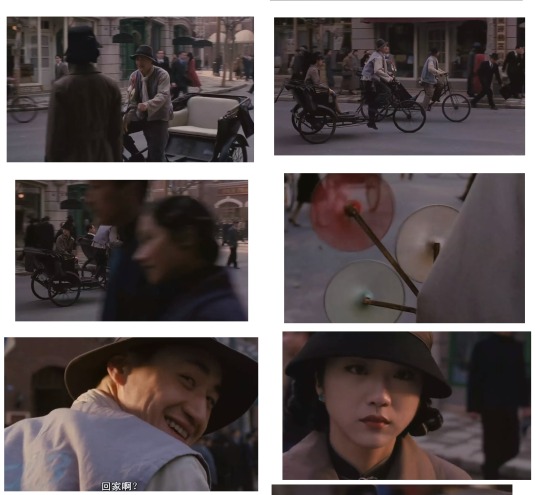
Although this color is dark, it is difficult to say that unhappy scenes. You can only understand this moment through the character's expression, but there is still no effect in the movie.

You can hardly feel the peeling of the characters and the environment when you look at the screenshot of the lens. The time of the intermediate driving lens is relatively long than that of the entire scene. Although you can know that it is "closed road", if you don't look at the final expression of the character, there is no delicate feelings.
And this scene is actually full of spies, and you must observe the action of everyone through each frame of the movie to discover it.
youtube
If you don't watch movies, it is difficult to experience such indifferent melancholy. If you read, you understand why music has a vital role in scenes and shots.
All is understood, and no words are necessary...
0 notes
Text
Talking Books With @touka-the-fallen-angel!

[What is this and how can I participate?]
Important note: I haven’t changed or edited any of the answers. I’ve only formatted the book titles so they were clearer, but nothing else. Because I’m incapable of shutting up, my comments are between brackets and in italics, so you can distinguish them clearly.
----------------------------------------------------------

[Image description: a square titled “Know the blogger”. Name & pronouns: Touka, she/her; country: United States; three adjectives to describe her: curious, empathetic & determined /end]
1. What is a book that surprised you (for good)?
A book that really surprised me in a good way was The Beautiful and Damned by F. Scott Fitzgerald. I was forced to read The Great Gatsby like every other hs student in the US and I didn't really like it to be honest. I understood the message of the book, but it was too knee deep in nostalgia for the south and the era to feel like a relatable work. So when I was recomended another book from this same author I internally prepared myself to be driven crazy by more nostalgia bait and overly descriptive drinks. Instead The Beautiful and Damned was an amazing take on the obsession with image and how it ties into class. I found it especially interesting, because this was done with two protagonists with their own tribulations. More interesting is that the main protags are said (through word of mouth) to be based on Fitzegerald and Zelda, his wife, which if true would be pretty cool.
[Oh, that’s good to know! I also didn’t like The Great Gatsby (and I’ve read it twice), so I’ll keep this book in mind!]
2. Last book quote you loved?
"I cannot make you understand. I cannot make anyone understand what is happening inside me. I cannot even explain it to myself." - The Metamorphosis by Franz Kafka
3. Do you prefer fantasy, sci-fi, or both?
Both.
4. Is there a book that everyone loved except you?
Twilight XD. Everyone was into Twilight when I was in middle school and I tried to get into it. I couldn't. So I had to pretend that I read all of Twilight for the rest of my middle school career.
[I have to agree! I read Twilight (the first book, I mean) just to be able to criticize it properly so I was also NOT into it. But I have to admit it was very easy and very fast to read so hey, whatever floats people’s boats!]
5. Is there a publishing house you especially like or you don't even notice these things?
I especially like penguin books. Their classic edition books have saved me a lot of money and their anniversary short story collection still provides me with hours of entertainment.
Free space!
Reading books outside of one's own culture is a must, because it helps to expand the worldview. Many usually stay with the literary cultures that they were introduced to in school and that is understandable. However, there are so many different styles of writing and frames of references from other countries that are not taught in the usual school setting. A few book reqs for the budding international reader:
One Hundred Years of Solitude by Gabriel García Márquez
Rashomon and Seventeen Other Stories by Ryunosuke Akutagawa
No Longer Human by Osamu Dazai
The Plague by Albert Camus
[Agreed, reading outside one’s culture is a must, so here is my obligatory post on why it’s important to read translations]
You can follow her at @touka-the-fallen-angel.
-----------------------------------------
Thank you, Touka! This was quite interesting.
Next interview: Wednesday, 30th of December
16 notes
·
View notes
Text
DuckTales 2017 - “Astro B.O.Y.D.!”

Story by: Francisco Angones, Madison Bateman, Colleen Evanson, Christian Magalhaes, Ben Siemon, Bob Snow
Written by: Christian Magalhaes
Storyboard by: Sam King, Kathryn Marusik, Rachel Paek, Stephan Park
Directed by: Jason Zurek
涼しい!

This is supposed to be the Huey season, and this time, we finally get an episode focused solely on the red sibling. In fact, the blue and green siblings don't even appear in this episode beyond Huey mentioning "the brothers" one time. We already start off with an issue Huey seems to have: he's so by the book, that at the Junior Woodchuck's celebration of National S'more Day, he has to specifically measure the graham cracker to marshmallow combo.
This overly specific measuring is made fun of by a bully who bares a striking resemblance to one of the Beagle Boys. The credits call him "Bully Beagle", though he doesn't appear long enough to reveal any kind of connection to them besides his looks. He does appear long enough to compare Huey to a robot, as he marvels at his own concoction that features many marshmallows and some donuts stuck between them. Everyone else laughs, because even a Beagle Boy is more relatable than him.

Definitely not speaking of robots, we get to see the return of Boyd, who is definitely a real boy and wants to be friends with Huey. To Huey's delight, he shows his true knowledge by commenting that his S'mores stick is cut perfectly to Woodchuck guidelines, and knows a guideline so well that he's able to speak it at the same time as Huey. It's no wonder that he's an expert with the way of the Junior Woodchucks, saying that he practically has it downloaded to his head!
Relieved to see another boy who follows the Woodchuck guidebook cover to cover, he tells Boyd to ready the fire for some by-the-book s'mores making. With all of those specific denials, even the people who didn't see his debut episode can repeat in their heads, "he's going to shoot lasers, he's going to shoot lasers, he's going to shoot lasers..."

Yup, he shot lasers. Thankfully, Huey has his back turned, claiming that their totally non-robotic and yet rule following selves make them a rare breed. Unfortunately, “rare breed” ended up causing a glitch in Boyd's memory banks, causing him to use his laser eyes in a way Huey couldn’t ignore, causing a fire. In a forest. Smokey Bear wouldn’t be too happy about how much this gets brushed off.

Huey makes it to Gyro's underwater lab, apparently keeping Boyd's eyes closed the entire time, to talk to Dr. Gearloose about that laser eye problem. Fenton Crackshell-Cabrera, the intern, tells him that he's a scientist, and he should be able to help...until Boyd opens his eyes and has lasers tear through one of the windows, which Manny the Headless Man-Horse has to lock up with metal doors.
He is at least ready enough to give him red sunglasses that stop the lasers, just like that character that Disney may or may not have the film rights to. Fenton decides to elevate this to Dr. Gearloose, who reveals that he has a connection to Boyd...

...as revealed by him backing away in fear.
Gyro: Manny, get this dangerous machine out of my lab!
Manny: (morses) Which one?
This is an actual second joke from Manny the Headless Man-Horse, even if it should be pretty clear which of the inevitably dangerous machines he's talking about.
Revealing his actual name to be 2BO, Gearloose tells Huey that he was one of his failed experiments. Or, rather, it was one of his failed experiments. Right from his very first interaction, it's clear there's a huge contrast between Gyro Gearloose's relation with what is essentially his own child and Huey's new friendship. The C3PO-like name, and him using pronouns more fitting for objects.
Huey does call out a few things about Gyro's behavior, and one of them is that he's usually saying that the inventions that were actively trying to kill people are just "wildly misunderstood." However, Gyro just knows 2BO is different, and this sudden personality change will be justified later. However, he does seem to have a sort of soft spot for the bad robot, as he offers a fix for that thing's problems. Unfortunately, he needs more fitting equipment than what he has in this lab, and the only place that would have it is the lab of his old mentor...in Japan.

No time for an opening, just the logo in Japanese and that's it. That's right, they're going to Tokyo, Japan, or Tokyolk, Japan. Not sure how to put that in kanji.

As soon as they land in Tokyolk, Gyro immediately gets slammed to a car by Inspector Tezuka. Besides the homage to Astro Boy creator Osamu Tezuka in her name, she's totally supposed to be Inspector Zenigata from Lupin The 3rd. A person who even looks like the titular guy Zenigata was chasing after cameos throughout this episode, but she has far more pressing matters at her hands, like capturing the crook that was making killer robots that destroy cities. As soon as one potential killer robot nearly gets caught, Lil Bulb distracts her with some binary graffiti and itself, and they run off to the lab.

Using GizmoDuck to break through the now abandoned old lab, him showing off he can partially transform with just the word “Blath”, Boyd can't help but say how familiar this place is. The intern just can't help but check out his boss's old stuff, too, putting on his old lab coat and looking at dusty microscopes.
Using the equipment, Gyro hooks Boyd up to a chair. To stop his malfunctioning for good, Gyro has to search through his memory banks to find his core. This means we get to see his past memories from reverse order, Memento style. It's not necessarily Rashomon style, but maybe that's just not how I remembered it.

We get to see Boyd's last two owners. Along with Doofus Drake, who is trying to ruin his mother's pearls, we see Mark Beaks, the guy that was trying to pass off Boyd as his, um . I must say, while it's not surprising that Mark Beaks didn't invent him like he said he did, as that's just his shtick for the last two seasons, it is a wonder that Boyd just happened to look exactly like a young version of him even before Mark Beaks took him in.
However, even an evil crook like Mark Beaks knew that 2BO is a sorry name for a little kid robot, and he was the one that would give him something close to a real name. He also didn't want to even touch him, never mind give him a hug, but he is at least smart enough to not touch garbage. By the way, that line about not touching really aged well, didn't it?

Gyro even reminds us of this contrast, as Huey remarks that Boyd must have had a terrible life living with a creep and a crook. Gyro simply remarks,
Gyro: It doesn't feel anything!
Interesting to have him be in the shadows in that shot, too, as if to show that he's the person with the wrong opinions here. This robot hatred ended up being so blatant, that Lil Bulb shorts out. This ends up distracting Gyro, leading to Fenton to come up with his own plan for Boyd: make him a superhero! It's a good time to do that, as Fenton's GizmoDuck arm notifies him of a robbery. They run off, not noticing that the security cameras happen to be on. Hmm, it is rather curious that this old lab still seems to have working equipment, as if the electricity bill is still getting paid.

As soon as those security cameras are shown, that bill payer is revealed to be Dr. Akita, the mentor of Gyro Gearloose, and the one scientist Gyro himself has interned for. We did see little glimpses of him in Boyd's memory glitch from the opening scene, but this is the first time we get to hear him speak. Anyone can guess he's evil; not only is he staring evilly at his old intern walking into his building, he's revealed to have an anime avatar on his computer. Ooh, the true mark of evil!

We cut to that robbery from earlier, as two pigs are about to be chased by two different cops. Wait, that shouldn't be right. Kind of missing the opportunity for Fenton to shout "thering Blatherskite", but it leads to a cool chase scene nonetheless, with GizmoDuck rolling around, and Boyd using his robotic biking abilities to bike across walls. GizmoDuck ends up capturing one of the bad guys, but the other?

Well, Fenton didn’t really get to the “what to do with the criminal after they get cornered” part, so Boyd politely asks her to take back that money that she obviously must have taken by mistake. Of course, she does not oblige. GizmoDuck does give him a pointer that the standing down should come after the criminal gets dealt with, but Boyd simply doesn’t want to hurt people. Well, so much for that plan.
It's here where Gyro fixes up Lil Bulb, and realizes that Fenton, the kid, and the not-so-kid are gone.
Gyro: IN-TEEEEERN!
Uh oh, Spaghetti-O's! That is kind of a note to Gyro's character, too. He doesn't call his intern by his name, either, and it seems he would use it pronouns for him if he could get away with it.
The next day, while Inspector Tezuka reveals that she caught the other burglar and will give that guy in the robot suit a stern talking to, Boyd would rather enjoy the sights of Tokyolk than go back to the lab again. Oh no, back to the lab again. You messed up, back to the lab again. ...sorry, that song will forever be stuck in my head.

Anyway, it's montage time! Not every scene has a joke about Boyd being "wired a little differently", as Huey put it earlier in the episode, as there are some relatively normal scenes sprinkled with Boyd literally sucking up bowls of Udon like a vacuum cleaner. I do mean literally, and I always mean literally.
It all ends with Huey on the observation area of Tokyolk Tower, remarking that hanging out with him proves that he's not a killer robot. Apparently, that's the best thing anyone has ever said to him, and that's sadly fitting considering his last three owners. As Huey puts his picture in the JWD, the wind blows it away. Huey grabs it, only to lose his footing on the tower, falling from it.

Left with no choice, Boyd had to show off one of his killer robot abilities again, but this time to prevent an accidental killing: his rocket feet! Unfortunately, they run into Gyro Gearloose, Fenton Crackshell-Cabrera and Inspector NoFirstName Tezuka, who all now seem to share the same opinion: those rocket feet just mean that his combat systems are active again. Gyro decides to show him the memory he was trying to get to.

He was made to be a robot that defended Tokyolk with his special abilities, like his laser eyes and rocket boots. No word on whether or not he has machine guns in his butt, though. However, much like his future inventions. We learn that this was the first robot that became evil, and ever since, his penchant for making robots continued. This gives his attitude towards his own creation a little more weight.
As an aside, while we get glimpses of his past self, this is the first time I was able to put a screenshot of it. I must say that it's a neat touch that Past Gyro looks like the original Gyro from the comics, and, by extension, the Gyro from the original 1987 cartoon. It goes a bit further than that, actually, and I'm not going to spoil it here.
This scene also reveals that fix was more like a deletion, and that makes Boyd real angry. Well, that, or maybe that anger was artificially caused by this episode's real villain.

No, not Glomgold, though I do wonder where he has been since this season started. Apparently, he's been selling Japanese energy drinks like Schwarzenegger did back in the 90's!

No, it was Dr. Akita, of course, and he has become a total bad guy since the day Boyd destroyed Tokyolk. He was hiding in the shadows, though that's mostly because living underground has given him an aversion to sunlight. I'm a little disappointed that gag doesn't continue after this scene.

This leads to the seemingly once an episode fight scene with a bunch of the characters we know and love and will still love. Specifically, this is GizmoDuck vs. the evil 2BO/Boyd. It is very anime fight scene, but not in the "lol isn't anime so wacky" kind of way. There's even a well animated Macross Missile Massacre, as shown here; they really knew how to do it.
A big reveal happens in the middle of this, and I will admit it's one of those cliche "the one part of the memory that changes absolutely everything that was just ignored for no adequate reason" scenes. It’s not that I don’t appreciate it, though, as this is where that "further than that" comes in.

To make it as vague as possible, this basically puts Gyro in the position to learn something in the end of the episode. In fact, this is more of a Gyro episode than a Huey episode. Sure, it's more of a Huey episode than, say, the Mervana one, but it's not like his character changed significantly in the course of this episode. I mean, Huey saw him as a kid since the beginning.
Can Gyro see his creation as a kid and potentially fix that "becoming evil" problem? The conclusion is rather sudden, mostly because they seemingly had to wrap it up in under 3 minutes, but it's still satisfying nonetheless. It changes the status quo even more than one might expect, too, but I already given away enough.
How does it stack up?
It's a great story about a character that may have only really existed just as a gag in one episode, with a great use of anime influences that never become the usual "lol Japan so wacky" stereotypes. No doubt about it, this is a 5 Scrooges episode.

Next, oh boy, another Ragnarok. Can't be any worse than the last time I had to cover one.
← Louie's Eleven! 🦆 The Rumble for Ragnarok! →
8 notes
·
View notes
Text
drops of sunlight {Chuuya}
Monday Morning 6:32
She hadn’t found him like this in months. The office was quiet, the whole floor was a graveyard. A feeling in the pit of her stomach led her to his office rather than her own--her intuition never failed her.
Pale streaks of sunlight lay flat across the carpet like vines growing over a wall. A single stripe barely reaches far enough to kiss the edges of his hair sprawled in a mess dangling off the side of his desk. The rubber band holding the longer strands away from his face hangs limply, barely holding together. Kouyou holds her breath waiting for him to exhale.
A habit she couldn’t drop from when he was a teenager and his body was still a mess.
His breath crinkles the corner of a paper; she releases the tension in her lungs.
There hadn’t been a situation that required Chuuya to sift through so many reports and documents with pages of important details in what felt like a year. The effort put forth in gaining the information was, in itself, unquestionably exhausting. For the most part Chuuya did well at managing his time, but everyone has their limits. Chuuya hit his wall before sundown last night, apparently.
Kouyou purses her lips as she strides towards Chuuya’s desk. Whatever stacks he’d previously created in a manner of organization had been destroyed by his upper body slumping forward as he dozed, and from what she could see from hovering above his head a few of the pages were stuck to his cheek. A quiet laugh fills the empty room. Kouyou brushes a thick lock of tangled hair from his forehead and quietly hums his name.
Chuuya’s finger twitches on the desk; Kouyou frowns. She rounds the desk and places the back of her hand on his cheek. His skin was warm. He’d always been a warm sleeper, waking up with flushed cheeks and straggly hair clinging to the back of his neck--it was worse when he had nightmares. From the sweat on his brow and the tightness of his jaw Chuuya had been plagued with a nightmare or two at some point in the night. His teeth grind on each other, brows knitting together in anguish.
Kouyou’s heart tightens.
Muscle memory leads one arm around his waist and one beneath his knees. Thankfully his couch is less than a foot away, Kouyou would have to ask him how a man so thin weighed so damn much. The couch groans under the added weight--Chuuya scrunches his nose before emitting a growl, barely low enough to escape through his clenched teeth. Kouyou kneels down and pulls the rubber band free from his hair before carding her fingers through the tangled locks. Softly she rakes her nails between each strand. She moves slowly, methodically, until the features in his face begin to soften.
The sun continues to rise sprinkling glittering gold on her back and across the side of Chuuya’s face. She only stops when a faint smile begins to stretch his lips upward, as it did when he was younger, a sign he’d finally found a scrap of peace in his dreams.
Tuesday 1:35pm
“Your aim is better.” Chuuya spits blood on the mat; Akutagawa freezes. “Eh? Just one is all you’ve got?” Midday sun bursts through transparent glass reflecting bits of dust twirling in the air. Akutagawa’s lungs forget how to inflate. Fear doesn’t cross him often, but this miniscule streak of uncertainty makes his blood run cold. Chuuya cocks his head to the side and wipes his reddened knuckles over his swelling lip.
Blue eyes narrow and meet Akutagawa’s unnaturally widened ones, granite catching the sun’s warmth leaving a lighter tint than normal. Expression looks good on Akutagawa, Chuuya thinks, much more appealing than the stoic, cold, unresponsive flatline he wore with daily consistency. Even this current goofy expression Chuuya can’t one-hundred percent place in a category. Confusion, apprehension, fear? Possibly? Akutagawa never feared anything, except baths. Chuuya frowns, recalling the staggering resistance Akutagawa posed during their time at the hot springs.
Akutagawa catches Chuuya’s shifting features. His stomach drops to the floor. He didn’t spar with Chuuya often, because Chuuya didn’t allow him to use his ability. He’d tried to once and Chuuya merely cemented Rashomon to the ceiling which left Akutagawa vulnerable, trapped. His fists clench at his sides, Chuuya raises his own and motions him forward with a single finger.
The air in the room is heavy with the scent of blood and sweat. Akutagawa’s shirt clings to his lithe body, and Chuuya has forgone his shirt completely. For a man who rarely uses martial art skills Akutagawa moves relatively quickly to Chuuya’s surprise and happiness. “Looks like sparring with me isn’t such a waste of time after all eh Akutagawa?” Chuuya flashes his teeth before his knee meets Akutagawa’s stomach.
Instinct overrides Akutagawa’s internal narrative laced with warnings, and his fist connects with Chuuya’s ribs. He can feel the muscles dent beneath his boney knuckles, and the air rushing from Chuuya’s lungs like a popped balloon. Chuuya staggers, leaning against the nearest wall with his hand clasped against his side. Akutagawa remains frozen for a second time in ten minutes, fear racing up his back and churning the acid in his stomach up to his throat. He gulps and catches Chuuya’s gaze.
Chuuya breaks out into a laugh, and rubs the back of his hand across his forehead. “Fuck, you really know how to hit with force now don’t you?” Chuuya’s smile expands, cheeks flushed and rosy. “Oi, help me out will you? You knocked the fucking wind outta me.” Chuuya extends his left hand, Akutagawa walks quickly and pulls Chuuya up by the wrist. “You should eat. Lunch on me in half an hour, yeah?”
Still hazily stunned Akutagawa nods; Chuuya smiles brighter.
Thursday 2:15am
For a weeknight the diner was uncomfortably crowded. Glasses clinking together in celebration of something ridiculous, the sound of forks scraping plates, and fresh coffee streaming from darkened grounds into a freshly washed pot. The mafia ran just enough protection to give its members a variety of places to go in the dark hours of the night. A bar for drinking and discussing work without fear of unwanted ears listening in, small restaurants for quiet date nights that offered protection against hits on loved ones, and sometimes hole-in-the-wall places with remarkably good food.
The booth was scratchy, but comfortable enough for Chuuya to slump against. For some god awful reason he’d taken up Tachihara on his offer of a pool game and drinks--unfortunately those drinks came a bit too fast and left Chuuya spinning. Not to mention it furthered his exhaustion from the work he’d done the previous day. Somehow, they’d ended up here. Kajii uttered something about breakfast food being the better of three meals and Tachihara had some ridiculous counter argument.
Breakfast meant coffee, and coffee meant Chuuya would be able to see straight-- so he followed them. With the warmth of caffeine and a fresh slice of toast and fruit ebbing away at his drunken haze he was beginning to think this was a very, very bad idea. Kajii had proclaimed some hypothesis that involved waffles and syrup and somehow related it to the act of death itself. Chuuya expected Tachihara to intervene and leave him without the role of reining Kajii in for once. Unfortunately, vodka made Tachihara extremely scientific, apparently, and talkative.
So. Fucking. Talkative.
“You’re putting the door on wrong!” Tachihara shouts, smacking Kajii hands away from their breakfast shack. For the life of him Chuuya couldn’t understand what constructing a house of waffles had to do with science, or death, other than their childlike mannerisms killing him slowly. Completely dismissing Tachihara’s slurred aggression Kajii dumps half a bottle of syrup over the upright waffles, babbling too fast for Chuuya’s ears to decipher. Tachihara stares into the syrup as if it was reading him his fortune, Chuuya sinks back into the booth and leans his head against the window.
“Oi! Don’t fuck with my coffee!” Chuuya reaches for his cup but it’s too late. Kajii’s experiment has drifted to his one chance of partial sobriety that now is a mix of coffee, a single sugar packet, and syrup. “What’d you do that for?!”
“I made it better, Chuuya - san” Kajii proclaims with an innocent blink from bloodshot eyes.
“Oh yeah?” Chuuya quips, a broad smirk fluttering over his face. “Drink it then.”
The air goes quiet at the table. Tachihara stops mid chew, bits of waffle flaking off and falling to his coat and jacket. Chuuya arches a brow; Kajii swirls the white mug, wafting it as if it were an expensive glass of wine. In one gulp Kajii swallows the mixture. His face turns a sickly green, and then pale, and then he is doubled over gripping his stomach. There’s something unnameable and entertaining about the entire situation that causes Chuuya to double over in laughter.
Perhaps it was the booze and the lack of sleep that made this peculiar disaster so funny to him, but a piece of him felt normal. Just a group of friends from work dealing with the ridiculously drunken decisions of another surrounded by other patrons in the same boat. For a split second in time he wasn’t a mafia executive and a dangerous weapon, Kajii wasn’t a bomb with a seemingly endless fuse, and Tachihara wasn’t a hired gun rolling the dice of survival each time he stepped out the door on a mission.
They were just in each other’s company, as friends, as humans.
#chuuyaxhappinessweek#chuuya#bsd#bungou stray dogs#nakahara chuuya#port mafia#kouyou#akutagawa#slight chuuaku and tachichuu ish#chuuya is just happy gdi#my writing#my writing chuuya
132 notes
·
View notes
Text
Pom’s Summer reads (as she was stuck in the hospital)
Hey guys ! Sorry I haven’t been around in a while. The reason is… I was back in the psych ward. Mental health is no fun. But this time around, I was so bored out of my mind that I actually took a look at the scarcely furnished, yet surprisingly eclectic hospital library. Which consisted of two shelves of donated books in various states of decay. But since beggars can’t be choosers, I went and started reading randomly selected books from this motley collection. And I thought it would be fun to make a reading list out of it to share my findings. I have terrible ideas.
So, here’s what I read over the last two weeks :

- Mythologies by Roland Barthes
Genre : Essay – Philosophy
Length : average
Available in English : partially
I had only read excerpts of this staple of cultural criticism before, so I thought it was high time I read the whole thing. This takes a look to the making of modern myths from a Marxist perspective, finding meaning in items as deceptively trivial as laundry detergent and haircuts in movies. This book consists of a first part made of a series of small commentaries, and a second part that takes a deeper look into the mechanisms and power of myth making. Some of the essays of the first part are not included in the English version of this book, presumably because the references studied were too “French” to speak to foreign readers. The references as a whole have aged (I had to google quite a few things, even as a French reader) but it speaks to the quality of the commentary that the thoughts expressed in this book are still relevant to our modern culture. You can probably find one of its most famous bits online, an essay about wrestling and the theatrical culture it illustrates.
This is an important and interesting book, but one that’s maybe a bit arid to read cover to cover : I found picking it up at intervals to read one essay or two was the best way to enjoy this book. You can of course also check out Barthes’ highly influential essay on the Death of the Author, but I also enjoyed his lesser-known essay The pleasure of the Text and his collection of Critical essays.

- The Sand Child by Tahar Ben Jelloun
Genre : Novel
Length : average
Available in English : Yes
Content warning : explicit sexual content
This was a weird, weird but pretty amazing one. Assuredly the best surprise of the lot. This starts off as a straightforward tale of a girl raised as a boy by a traditionalist father in modern Morocco as told by a storyteller on a marketplace, but it quickly devolves into several levels of metatextuality and dreamlike elements until story, characters and storyteller are interweaved into a reflexion about the nature of stories itself.
Aptly enough, this reminded most of Sandman, but also of Akira Kurosawa’s Rashomon, both excellent things of which to remind someone. This is also the rare reflexion on gender roles and identity within the context of Islamic culture. But most of all, this is all written with a unique style, as if the author was drunk on language ; it’s a bit hard to get into, but it’s also captivating at the same time. Of all the books in this list, this is the one I would reread again and again just to try and understand all its levels. If you like this kind of surreal literature, definitely check this one out.

- Oyster by John Biguenet
Genre : Novel
Length : average to long
Content warning : mild violence
This was a frustrating one. It’s not a great book, yet it could have been one. This is yet another story of rivalry, secrets and revenge between two poor white families, this time living from oyster farming in Louisiana in the late fifties. The plot is fairly standard, and narrated in such a way that it constantly gets in the way of its dramatic potential. The writing is I think the problem here, especially around dialogue and plot progression, making the whole thing feel flat. Which is a shame because when the book lingers on details of the life of poor oyster farmers, it can be remarkably evocative.
This is the kind of book I want to put in a shaker and shake to put each element back where it belongs. I’m not difficult when it comes to Southern Gothic : I will basically read anything as long as it reminds me even a little bit of William Faulkner and Tennessee Williams. So it was frustrating to see this one being able to conjure its own atmosphere while not sticking the landing with its story. If you know of any good modern Southern Gothic novels, please send them my way, I’m hungry.
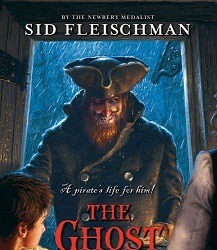
- The ghost in the Noonday sun by Sid Fleischman
Genre : Novel
Length : short
I have no idea how much of a staple of children’s literature this book is, so maybe all of you are already familiar with it. Personally, I hadn’t read it in quite a while since the version we have at home is now missing some key pages. But if by chance you haven’t read this, please go invest an hour of your life into reading this funny, witty and earnest pirate story about a teenager who gets kidnapped by a superstitious pirate who believes he’s able to see ghosts in order to locate the treasure of his old captain who was buried with it.
In a just world, there’d be a cult movie based on this book instead of one of dubious quality staring an erratic Peter Sellers. This is children’s literature of the best kind : one that takes its audience seriously, is able to create an atmosphere and is still a fun to reread as an adult. This was kind of super-nostalgic to me to pick this one, but I couldn’t resist.
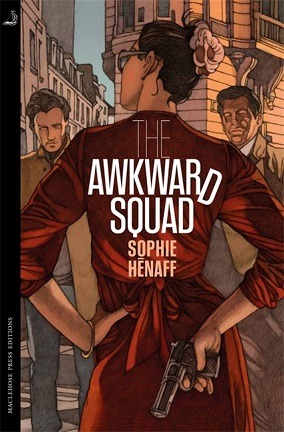
- The Awkward Squad by Sophie Hénaff (and its sequel Stick together)
Genre : Novel – Crime
Length : average
Available in English : Yes
I had to have read at least one crime novel in this lot, but in the end I only read two, since the other options were Mary Higgins Clark books and since I have a grandmother, I had already read those. It’s a shame that French crime novels don’t have as much of an international reputation as Scandinavian or American ones, since we do have an interesting tradition of our own : books mainly based on ensemble casts of motley characters, with a poetic streak and a sensitivity to absurdism. The premise of this series is that in order to get better statistics, the new policer commissioner has decided to regroup all undesirable police officers they can’t fire in one single squad, and make sure this lame duck unit doesn’t attract any attention. But some people from this unit have of course decided otherwise.
These books held pretty well as far as crime novels go, they are a lot of fun at times and read easily. The character work and dialogue are definitely this series’ best asset, as it is the case with many French crime books. If you want the best the genre has to offer, check out my all-time favourite, the Adamsberg series from author Fred Vargas, in order : The Chalk Circle Man, Seeking whom he may devour, Have mercy on us all, and Wash this Blood clean from my Hand.

- The Three-Arched Bridge by Ismail Kadaré
Genre : Novel
Length : short
Available in English : Yes
This was hardly a surprise that I loved this one : I’ve been a fan of Kadaré for a while. This is yet another of his books that explores the frontiers of reality and legend, superstition and magic within a fascinating historical context. Here, his subject is the building of a bridge in Albania toward the end of the 14th century, as the Turkish invasion is looming. The narrator, a monk, relates both political and mundane events surrounding the isolated region, as increasingly troubling phenomenon surround the construction site, announcing the troubled future of the country.
I do love my historical/supernatural novels, and Kadaré is a master of the genre. This reads easily while making a lasting impression and leaving you hungry for more. If you do, I can’t recommend enough checking out more of Kadaré’s work, his classic The General of the Dead Army, and my personal favourites The Pyramid and The Ghost Rider.
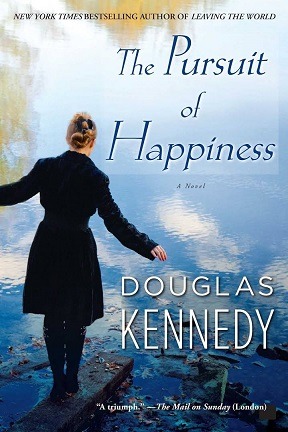
- The Pursuit of Happiness by Douglas Kennedy
Genre : Novel
Length : long
I picked this one deep in my “I’m fucking sick of reading, but there’s still nothing else to do” phase, since I needed something that would be easy to read and at least somewhat good, and old Douglas did not disappoint : this book might be almost 800 pages long, it reads in a dedicated handful of hours. This is primarily the story of two women, one who just lost her mother and the other who appears in her life after the funeral, apparently knowing a lot about her family, to give her a manuscript retracing her story. The portrayal of the main characters is realistic, both are flawed individuals with distinct stories and personalities, so cheers to that.
This is the kind of familial saga-that’s-also-a-reflexion-on-destiny-and-the-American-dream you never get tired of until you do. Don’t let my snide deter you though : this is a very good book, maybe just not singular enough for its genre. If you’re looking for something more particular, you can of course check out Steinbeck’s East of Eden, the metric by which all American familial sagas are judged, and Roth’s American Pastoral, which contrary to what you may have heard, is a weird goddamn book.

- Allah is not obliged by Ahmadou Kourouma
Genre : Novel
Length : average
Available in English : Yes
Content warning : extremely disturbing and graphic description of atrocities in wartime
A first-person description of tribal wars in Liberia and Sierra Leone during the nineties from the point of view of a fictitious child soldier. It doesn’t pretend to stick by its premise though, and dives into detailed record of the political climate, all while taking us through the daily horrors of life in war-torn countries. The extremely down-to-earth and downright crude descriptions are interweaved with magic realism rooted in West African voodoo and culture.
This one was one of my favourites, despite the writing and narrative bordering on gimmicky at times ; especially at the end, where the story seems to have exhausted itself and seems more interested in recounting the political history of the region. The subject in and of itself is fascinating (and this is a great read if you’re not familiar with it) but sorts of impinges on the main storyline and the development of its characters.
Despite its flaws, I can only recommend this book, especially if you’re looking to delve into West African literature as this makes for a good introduction to the genre. Be aware however that this book is extremely hard to stomach and triggering in about every way possible. If you do like it, I recommend checking out my favourite book by this author, Waiting for the Wild Beasts to vote.
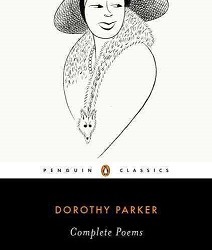
- Hymns of Hate by Dorothy Parker
Genre : Poetry
Length : short
I have a complicated relationship with poetry : as in, I am fond of it and some poetry books have come to mean a lot in my life, yet for some reason I never seem to be in the mood for picking one. So the reason this chapbook got picked is probably that your brain functions differently when the world around you is an ocean of noise and agitation due to a little event called the World Cup. Yes, even at the hospital, the French victory was dutifully celebrated, so this was the best time to isolate yourself with some earplugs and a poetry book.
Dorothy Parker is an acerbic poetess from the twenties who takes a comical and critical look at society, which leads to what I’d call comedy roast as poetry. It’s not the most moving kind of poetry, but it will make you laugh and reflect on yourself a bit, as I can guarantee you’ll recognize yourself in at least some of the vivid portraits this book draws. Of course, since I read it in French, it probably lost a lot of its musicality, which is the eternal dilemma when it comes to poetry : would I rather have something be lost in translation, or in reading in your non-native language ?
This kind of impertinent poetry, even if it doesn’t get as much press as big romantic oeuvres, is still a breath of fresh air that puts a smile on your face while still giving you an insight into the author’s personality. The only poet I can think of that produced the same effect on me is Jacques Prévert. I highly recommend checking out his two chapbooks Paroles and Stories.

- Six characters in search of an author by Luigi Pirandello
Genre : Play
Length : short
Available in English : Yes
So before you say anything, I didn’t know he was a fascist before I picked this one. But you do now, so feel free not to read this one as a matter of principle. That being said, this is a very good play. This is the kind of hyper-conceptual play that interrogates the relationship between characters, writer and comedians. The story is exactly what it says in the title : six characters imagined by an author but who never got their play written tumble into a theatre as actors are repeating a play and ask them to write their play.
This play has stage directions for days and is a little bit hard to get a sense of when you read it instead of seeing it, yet once you get how the whole thing works, the ideas expressed are extremely interesting. This reminded me of Ionesco’s works, particularly The bald Soprano and the criminally underrated The Chairs. The theme of characters escaping the grasp of their authors can also be found in Paul Auster’s Man in the Dark which, while by no means one of the author’s best works, is still a fun and meditative read so don’t hesitate to check it out.

- What money can’t buy, the moral limits of markets by Michael J. Sandel
Genre : Essay – Economy
Length : average
I picked this one primarily because it was the only one in English, and also because I like to periodically remind myself why I left business school. I ended up having a good time reading it, because it’s more about thinking the market than explaining it. This book discusses the things that money can buy today – cutting in line, naming rights, stakes on someone’s life – and whether we should be alarmed of this growing market mentality. In the true tradition of English essays, this book makes its thesis clear at the beginning and then reiterates its point through examples. This is completely different from the French tradition of essays, which starts at the observable phenomenon and then takes us to its core thesis through organic reasoning. This means that past the introduction, you’ll know what this book is trying to prove, and the rest of the book is more about illustrating the demonstration. However, each set of examples come with their own ethical and practical problems, and you end up being more conflicted than you originally thought. A fiery onslaught against capitalism it is not, but this has the advantage of considering market mentality from the inside and then wondering how it looks from the outside. If nothing else, it should give you a good set of arguments to shut up libertarians and their ilk.
So that’s all I have today. Do tell me if you want me to make more reading lists like this !
11 notes
·
View notes
Photo

A Journey through the Entire Kurosawa Filmography [from My Current Approximation of Least to Most Favorite] 🎥 Part VII: Best of the Best Chapter 1 - Works of Staggering Genius 🎞️ 7. Throne of Blood [1957] Throne of Blood is not only my favorite of Kurosawa's Shakespeare adaptions, but my favorite adaption of Macbeth, & further, my favorite Shakespeare adaptation overall. Aside from a couple specific moments that require it to slow, it moves long quickly, excitingly, & powerfully. It is brilliantly shot, delightfully performed, & just purely enjoyable Shakespearean film entertainment. 6. High and Low [1963] High and Low is the last of the noir like films that Kurosawa did, & in my opinion, easily the strongest (even if Stray Dog is the most noir-ish). It is a major influence on police procedural films to follow, particularly domestic drama & kidnapping related police procedurals. It is Toshiro Mifune's penultimate film with Kurosawa & is extremely tightly constructed, outstandingly performed & photographed, & perfectly paced (particularly for a movie its length). 5. Rashomon [1950] While Drunken Angel & Stray Dog were very strong films that came before, Rashomon was Kurosawa's first international hit & is still considered among the greatest films ever made by many. It's unique storytelling style is the inspiration for the term "Rashomon effect", about the unreliability of eyewitnesses (as they will each tell the tale differently), & nothing had been done quite like it before in film, though so many have since. & just so beautifully shot. 🎬 We've reached the top 7, the best of the best. 7 of the greatest Japanese films ever made, they stand out there among the greatest films, period. These 3 are each works of just staggering genius, & each in 3 completely different styles. • • • #kurosawa #akirakurosawa #KurosawaFilmography #kurosawathon #all30films #iLoveMovies #dvd #blurays #dvds #bluray #kurosawafilms #kurosawamovies #bestofthebest #throneofblood (#spiderwebcastle #akirakurosawasthroneofblood #macbeth ) #1957 #highandlow (#highandlow1963 #heavenandhell ) #1963 #rashomon (#akirakurosawasrashomon ) #1950 #toshiromifune #tatsuyanakadai #takashishimura (at Jersey City, New Jersey) https://www.instagram.com/p/CLTY2oxD3o7/?igshid=bzg99qfxm8zk
#kurosawa#akirakurosawa#kurosawafilmography#kurosawathon#all30films#ilovemovies#dvd#blurays#dvds#bluray#kurosawafilms#kurosawamovies#bestofthebest#throneofblood#spiderwebcastle#akirakurosawasthroneofblood#macbeth#1957#highandlow#highandlow1963#heavenandhell#1963#rashomon#akirakurosawasrashomon#1950#toshiromifune#tatsuyanakadai#takashishimura
0 notes
Link
WILLIAM MAKEPEACE THACKERAY’S VANITY FAIR calls itself “A Novel Without a Hero”; My Struggle has a hero, of sorts, but one who finds himself in a novel without a plot. Instead, the book has a project: to tell the truth about its author, and thereby reveal the deeper meaning of seemingly trivial events. Now, after more than a million words, Knausgaard says that his project was, in a sense, doomed: “It has been an experiment, and it has failed because I have never even been close to saying what I really mean.”
How could anyone write such a massive autobiographical novel or “autofiction” without saying what they mean? One reason might be internal: the difficulty of finding a true language to describe what goes on inside people. My Struggle is a philosophical novel in search of the right words, seeking help from Shakespeare, Proust, Heidegger, and many other masters of expression. Then, quite differently, there are the external constraints, which exist because the novel is a legal and public document. Book Six opens with a bitter conflict between Knausgaard and his uncle Gunnar, who claims that Book One, A Death in the Family, is a tissue of lies about the death of his brother, Knausgaard’s father. Gunnar threatens to file suit for defamation of the family’s honor, and thus prevent Book One from being published.
Novelists have often got into trouble for turning people they know into fictional characters. Their first line of defense has usually protected them — in giving their models a different name, then adding the disclaimer about “no resemblance to living persons.” So Lady Ottoline Morrell becomes “Hermione Roddice” in Lawrence’s Women in Love, or “Priscilla Wimbush” in Huxley’s Crome Yellow. The victims can only lick their wounds, and vow to never again make friends with a novelist.
When Knausgaard cowers under his uncle’s threatening emails, his wife tries to console him by saying: “But it’s a novel, Karl Ove.” “Yes,” he replies, “but the whole point is it’s meant to be true.” If it’s true, then his characters must be given the same names that they have in real life. They are not independent creations who exist only between the pages of a book; rather, real names are supposed to make My Struggle a more solid work than almost any other novel written before it. Yet, under the threat of legal action, Knausgaard does end up changing the first names, and suppressing the family names, of all his father’s relatives — those who had been outraged by his depiction of his father as an incontinent alcoholic. He goes further: the great villain of Book One no longer has a name at all. He is just referred to as “father,” as if no name is better than a false name. But this turns A Death in the Family into a myth, about any father who inspires hatred in his son and is punished with a sordid death.
Whether or not under a true name, Knausgaard’s characters would be easily identifiable in a small country like Norway. So, he must fall back on the Rashomon defense: this is the way I remember it, and I can’t help it if you remember things differently. Was Knausgaard’s father found in the bathroom, or in his armchair, surrounded by empty bottles? Was he still alive when the ambulance came, or already dead? Did Knausgaard and his brother, Yngve, spend days cleaning the house afterward? Or had their uncle done most of the work before they arrived, and found only a handful of bottles?
Knausgaard ‘s ambition is to tell “the truth” about his family, but uncertainty keeps creeping in. Even with brute facts, like how many bottles were in his dead father’s house, different observers come up with different numbers. Knausgaard spent the ’80s as a student of literature and art history, immersed in the theory world of that time. But the commonplaces about relativism and the social construction of reality are no longer part of his foundations as a writer. My Struggle presents the world as it appears after the theory wave has receded, leaving Knausgaard gasping on the shore.
My Struggle may not have a theory that determines its message, but it is still more of a philosophical novel than a traditionally realist one. Observing his children, Knausgaard sees that “[w]hat they had, and what I had lost, was a great and shiningly obvious place in their own lives.” As they grow up, though, “meaning diminishes, or […] at least becomes less self-evident.” Living with small children — making breakfasts, going to the park, refereeing their squabbles — does not confer authenticity on their caretakers. It generates boredom and frustration rather than existential insight. Small children are creatures of passion: they don’t worry about meaning because they are too busy trying to get what they want, in the moment. One of Knausgaard’s virtuoso set pieces, in Book Two, is a 60-page description of a birthday party for Swedish four-year-olds. The parents spout every imaginable cliché about healthy eating, sharing your toys, et cetera, while anarchy reigns. Knausgaard has to admit that only a dogged sense of duty keeps him engaged with his little ones.
Novels used to have a formula for what makes life meaningful: climbing the social ladder, acquiring wealth, marrying Mr. or Ms. Right. Novelists like Dickens, Balzac, or Zola examined how the great social machine works, and perhaps how it might be improved. But My Struggle does not send a message through some kind of standard plot, nor does it have much to say about social issues (except for the origins of Nazism, of which more later). The popularity of “Scandinavian Noir” rests on its exposure of the dark underside of the Nordic model, but Knausgaard keeps quiet about Norwegian politics. Nor does he say much about two of the standard motives that give shape to novels — money and sex.
Knausgaard admits that he is awkward and impulsive about money; when he doesn’t have it he borrows, when he does, he spends it rashly. In a traditional perspective, it might be said that the plot of My Struggle is “obscure provincial writer succeeds in becoming rich and internationally famous.” Yet Knausgaard’s battle with life continues, just as intractably as before. He is not one of “those ruined by success,” as Freud described them, because he was ruined before and stays ruined afterward.
The other zone of silence in My Struggle is about sex: from Augustine and Rousseau onward, any confessional autobiography is expected to reveal the author’s sexual misdeeds. Knausgaard refuses to offend former partners by saying what happened in the bedroom; alternatively, he sends them the manuscript and invites them to cut anything they want to keep secret. The end result in either case is the same: sex may be at the root of Knausgaard’s struggles, but it is largely excluded from his novel. Still, in a novel that sets out to “tell all,” the reader is tempted to fill in some gaps. In Book Four, Knausgaard describes his uneasy relations with the teenage students he taught for a year in Northern Norway. In Book Six, he confesses that he had a “strong and secret desire” to sleep with one of them, a girl of 13. He did nothing to put that desire into action; but what is action? In his first novel, Out of the World (1998), the protagonist does sleep with the girl. My Struggle says that this was “a simple act that never took place,” but in the earlier novel a place is given to it:
The novel is a place where that which cannot be thought elsewhere can be thought and where the reality we find ourselves in, which sometimes runs counter to the reality we talk about, can be manifest in images. The novel can describe the world as it is, as opposed to the world it ought to be.
Plausible enough, yet it follows that My Struggle is not a true novel in these terms, because in it Knausgaard does not feel free to describe certain things he did, or even thought about doing. What fills the gap, in the first third of Book Six, are two parallel narratives. One is about Knausgaard’s negotiations with family members who want to rewrite his book or suppress it altogether. The other is about his children, who might control every moment of his life except for the hours when he can steal away and write.
Why should huge chunks of this novel be devoted to the doings of three toddlers? For a justification, Knausgaard invokes the Russian literary critic Viktor Shklovsky:
[W]hat the novel can do, and which perhaps is its most important property, is to penetrate our veils of habit and familiarity simply by describing things in a slightly different way, for example by being insistent with respect to some particular state of affairs, let’s say describing a child’s pacifier over a whole page, whereby the real child’s pacifier would subsequently present itself differently.
Shklovsky defines art as a technique of de-familiarization. The forces of habit, and our preconceptions about what might be going on, are always pulling us down into a state where we are only half-alive. Art exists to bring reality back into focus, or simply to wake us up. Starting with the raw materials of everyday life, art makes them seem new and fresh. It “makes the stone stony.”
A Rembrandt self-portrait may awaken us to the essence of old age, or a Kafka story to the essence of bureaucracy. But those effects are brought into being by style; and long stretches of Knausgaard’s novel seem to fall back on mere reporting of actions and reactions. “The novel is the form of the small life,” he says in Book Six. Yet it can be the form of the large life too; and even the story of a small life must offer more than mere documentation. In Knausgaard’s defense, one could say that he convinces us that, behind his small lives, something much bigger is hiding. From time to time, his plodding style changes gear, taking his readers up into the realm of the sublime:
I saw all this: people swarming on the long city beach and on the wide footpath behind it, with cyclists and roller skaters whizzing by, the row of concrete blocks from the 50s or perhaps the 60s, the city’s final bastion against the sea, that great light-catcher, which was in no way dramatic here in the strait facing Denmark. The couples and the families sitting all around us, summer-clad and tanned, the big sky above us whose blue had no end until evening, when it would fade to gray and the first stars would seem to emerge from the space beyond, making visible its enormous distances. My own children sitting on their chairs with their short legs sticking out in front, absorbed in their own little worlds; ice cream wrappers, dripping lollipops and ice cream cones. Linda, now and then wiping their mouths with tissues, her eyes almost hidden behind her sunglasses. I saw all of this, though as a film, something of which I myself was not a part, my thoughts and feelings being somewhere else.
Knausgaard mentions that this mundane evening at the beach takes place a few miles from Hamlet’s castle at Elsinore. It promises something beyond the deadly blankness of bourgeois life, even if it is impossible to escape that life completely.
¤
Another way to situate My Struggle is to recognize that there is something that stands above it. “I had always,” Knausgaard writes, “from when I was nineteen […] considered poetry to be the pinnacle. What poetry was in touch with was something I was not in touch with, and my respect for poetry was boundless.” In Book Six, the pinnacle is the poet Paul Celan, a Romanian who wrote in German. Until he comes on the scene, My Struggle has been preoccupied with the family conflicts over the appearance of the first two books. Now these squabbles are set aside as Knausgaard plunges into the darkness of the 20th century: first with Celan’s two great poems about the Holocaust (where both his parents perished), and then with the predecessor of Knausgaard’s novel, Hitler’s Mein Kampf.
Celan, the victim, produced two poetic masterpieces: “Death Fugue” and “The Straightening.” Hitler, the perpetrator, produced a book that was, in literary terms, worthless. But Celan’s voicing of the sublime was not enough for his personal survival, and he drowned himself in the Seine in 1970. The noble man, poet, and genius, ended in despair. That prompts Knausgaard to seek understanding of Celan’s nemesis, the ignoble man who nonetheless set a nation on the march.
Is this turn in the novel a regrettable case of “Godwin’s Law”: that any protracted argument is bound to bring in the example of Hitler? Why should the middle third of My Struggle be a detailed examination of Hitler’s contribution to “autofiction,” set off by the incidental discovery that after one of Knausgaard’s grandfathers died a copy of Mein Kampf was found among his effects? Knausgaard says that the choice of My Struggle as a title was a friend’s idea. But once he had accepted it, he was under an obligation to explain the differences between his project and Hitler’s. Both might be considered obsessive egotists, but Knausgaard’s self-expression was an attempt at internal understanding, while Hitler wanted to recruit followers by exploiting “the longing to belong” and “the we’s need of a they.” Knausgaard makes a further claim: that it takes an artist to explain Hitler’s formative years, as opposed to a historian like Ian Kershaw, who simply sees Hitler as evil from the cradle.
Kershaw describes Hitler’s adolescence as an “indolent and purposeless existence […] [he] saw fit to do no more than dawdle away his time drawing and dreaming.” But Hitler did not lack for a purpose, Knausgaard argues: he wanted to be an artist, and he became embittered when he was twice rejected for admission to the Vienna Academy. European capitals were full of such maladjusted young men (and van Gogh was unusual only in that he belatedly succeeded). If not for World War I, and the chaos that followed, Hitler’s rise to power would have been inconceivable. Knausgaard does not say this to exonerate Hitler, but to show how a failed artist and homeless drifter managed to move to the very center of political life:
Only someone who stands outside the social world knows what the social world is; to those within it, it is like water to a fish. Hitler […] stands outside the we, and yet he longs for it, and it is this longing his audiences sense when he speaks, the longing for the we being the very foundation of the human. […] this is the truth of Hitler, his longing to be a part of the we touches something deep within that we itself. […] The simplest is the truest, and hatred of the Jews represents the simplest thing of all, the we’s need of a they, the basic mimetic structure of violence […] the sacrifice of a they in order that the we may prevail.
Hitler’s understanding of this dynamic came in part from Dietrich Eckart, an intellectual who became a mentor to him. Even before they met, Eckart knew the kind of person who could make Germany great again:
We need someone to lead us who is used to the sound of a machine gun. Someone who can scare the shit out of people. I don’t need an officer. The common people have lost all respect for them. The best would be a worker who knows how to talk. He doesn’t need to know much. Politics is the stupidest profession on earth.
Eckart wrote this a hundred years ago, and Knausgaard quotes him in 2011. Whether it might be relevant to populism in 2018 can be left to the reader to decide. What Eckart surely achieved was to make his rough diamond into someone acceptable in polite society, and to make Hitler’s dislike of Jews into an organizing principle for the coming Nazi regime. Knausgaard’s unwavering focus is on the emotional raw material that is exploited by politicians. Hitler explained it well, in 1922, walking home from one of his miniature rallies in Munich:
Herr Hanfstaengl, you must not feel disappointed if I limit myself in these evening talks to comparatively simple subjects. Political agitation must be primitive. That is the trouble with all the other parties. They have become too professorial, too academic. The ordinary man in the street cannot follow.
Hitler, Knausgaard suggests, was not just some sort of evil mutant. He grasped what millions of his countrymen wanted, and gave it a voice. Even paranoids have enemies, says the joke; what is not a joke is that even paranoids have friends — armies of them, in Hitler’s case. The longing for a “we,” a single body of authentically German “folk,” and the complementary need for a scapegoat, would have brought forward some other Führer if Hitler had not risen to the occasion.
¤
Knausgaard’s inclusion of a detachable essay on Hitler in his novel must stand or fall on its merits. If an artist can provide a deeper insight into Nazism than a historian or sociologist, then the attempt can be justified. But having made the attempt, Knausgaard reverts in the final third of Book Six to trying to justify the moral status of his own project. Here he must strike even closer to home, by revealing how the construction of My Struggle coincided with the demolition of his marriage to Linda Boström Knausgaard.
Nancy Milford’s biography of Zelda Fitzgerald began a thriving tradition of presenting the wives or partners of male writers as victims of their husbands’ success — and just as often, as the ones who made that success possible. Knausgaard wants to do justice to his wife, but he has also pledged himself to telling the truth as he sees it. To be true, but fair, when describing one’s own marriage, is always going to be a near-impossible standard to meet.
Knausgaard’s first attempt to narrow the conflict is to say nothing about his wife’s father, and only a few innocuous details about her mother. But that only puts more weight on the central duel, between husband and wife; and Linda Knausgaard is not a happy helpmate to her talented partner:
“There’s so much contempt in you,” she said. “I know you look down on me.”
“Look down on you? I certainly do not!” I said.
“Yes, you do. You think I do too little. I whine all the time. I’m not independent enough. You’re sick of this life of ours. And of me. You never tell me I’m beautiful anymore. Actually I don’t mean anything to you. I’m just someone you live with who happens to be the mother of your children.”
Knausgaard may contest the letter of his wife’s diatribe, but he has to agree with its spirit:
The truth was that when I sat down to write the novel I had nothing to lose. That was why I wrote it. I wasn’t only frustrated, the way you can become when you live as a parent with small children and have many duties and have to sacrifice yourself, I was unhappy, as unhappy as I have ever been, and I was all alone. […] I often thought about leaving, sometimes several times a day, but I couldn’t do it.
And how does My Struggle reach its conclusion? With Linda Knausgaard’s utter defeat: first taking to her bed with paralyzing depression, then agreeing that she needs to be hospitalized for bipolar disorder (and not for the first time). The novel’s endless wanderings and digressions are now seen to converge on a simpler narrative: it is a book that begins with the death of a father and ends with the death of a marriage. After that, Linda Knausgaard’s vindication, if it can be called that, comes from the publication of her own novel, The Helios Disaster, which seems to be a reckoning with her own father.
In 1930, Henry Miller began writing Tropic of Cancer, a vanguard work of “autofiction.” He called his book “[f]irst person, uncensored, formless.” Knausgaard may have started My Struggle with similar ideas. But he found himself inviting others to censor what he had first written about them, and, more importantly, censoring himself. The “first person” turns out to be accountable to the opinions of second persons: he has to tell you how many diapers he changed, and how often he washed the kitchen floor (and that his wife told him he was doing it wrong). Then, the narrative isn’t really “free form” when much of the book resembles either a counsel’s closing plea for the defense, or a confession about how he failed to be quite as politically correct as his Scandinavian peers. Knausgaard’s giant book does not make him into a giant personality. Yet that is part of the book’s fascination: we keep reading — if we do — because Knausgaard gives such a complete and heartfelt portrait of the beleaguered masculinity of our time.
¤
Paul Delany, emeritus professor at Simon Fraser University, has written previously for LARB about George Eliot and Svetlana Alexievich.
The post The Form of the Small Life: Karl Ove Knausgaard’s “My Struggle: Book Six” appeared first on Los Angeles Review of Books.
from Los Angeles Review of Books https://ift.tt/2DgOD3K via IFTTT
0 notes
Text
Book review: Vietnam War through lives of those profoundly shaped by it

Knopf
“The Vietnam War: An Intimate History” by Geoffrey C. Ward and Ken Burns
By Mark Atwood Lawrence, Special To The Washington Post
Few histories of the Vietnam War shy away from contentious questions or bold conclusions. Was the United States right to wage war in Southeast Asia? Why did Washington fail to achieve its objectives? What are the key lessons of the American defeat? Authors have clashed for years over the answers, making the war one of the most hotly disputed topics in all of American history.
Geoffrey C. Ward takes a different tack in his “intimate history,” the exceptionally engaging, if not wholly satisfying, companion book to “The Vietnam War,” the 18-hour documentary by famed filmmaker Ken Burns, which premiered Sunday on PBS. Rejecting clear-cut judgments, Ward aims instead to capture the war’s ambiguities by telling the story through the varied experiences and emotions of ordinary men and women whose lives were profoundly shaped by it.
“This was a war of many perspectives, a Rashomon of equally plausible ‘stories,'” Burns and his co-director for the television series, Lynn Novick, write in the book’s introduction. Both the documentary and the companion volume, they assert, give voice to “seemingly irreconcilable outlooks” reflected in “as many different perspectives as our narrative could accommodate.”
This approach will be familiar to anyone who has watched Burns’ award-winning documentaries or read the accompanying books over the past 30 years or so. On topics ranging from the Civil War to baseball to the Roosevelt family, Burns and his team have offered a broadly affirming vision of American history that provokes less by stirring debate than by tugging at viewers’ heartstrings with emotionally charged portraits of individuals at the center of their stories.
It’s unquestionably an appealing formula, and Ward’s companion book, a visually stunning tome weighing in at more than 600 pages, overflows with moving profiles of not just soldiers, sailors and airmen, but also doctors, nurses, prisoners, journalists, activists, mere bystanders and more. For example, Ward, who also wrote the script for the television series, unfolds the life story of Denton “Mogie” Crocker of Saratoga Springs, N.Y. After growing up on stories of heroic fighting men, Crocker defied his adoring parents by enlisting in the Army in 1964, only to be cut down by machine gun fire two years later, just short of his 19th birthday, while trying to capture a hill in South Vietnam’s Central Highlands.
On the communist side, Ward tells the story of Nguyen Thanh Tung, a southern-born revolutionary who survives the war despite shrapnel wounds to her leg and unspeakable losses along the way. Four of her brothers died fighting the French and another four battling the Americans. She also outlives her two sons, both born in dank underground tunnels where communist forces took refuge from the fighting above.
These portraits are accompanied by a spectacular array of photographs likely to be the book’s most striking feature for many casual readers. Predictably, the volume includes many old classics, including widely published photos of a South Vietnamese police chief executing a communist suspect and an American chopper lifting off a rooftop during the final collapse of Saigon in 1975. But it also features hundreds of evocative images — many of them focused tightly on the facial expressions of everyday Americans and Vietnamese – likely to be unfamiliar even to experts on the history of the war.
The overall effect of the vignettes and photos is to show how people far removed from the corridors of power were swept up in events beyond their control, often with tragic consequences. The stories suggest parallels in the ways Americans and Vietnamese were victimized by questionable, even immoral, decisions by political and military leaders on all sides.
Ward is less successful when examining those leaders, who get little of the nuanced, sympathetic attention reserved for the book’s cast of lesser-known characters. Perhaps partly as a result of Burns’ and Novick’s decision not to interview former government officials for the project, high-level policymakers often seem comparatively one-dimensional.
To be sure, Ward provides a sprawling, almost encyclopedic account of decision-making by politicians, diplomats and generals, the relatively familiar stuff of many conventional histories of the war. Over 10 densely packed chapters, the book reaches back to the French colonial conquest of Vietnam and the early development of Vietnamese nationalism before delving into the peak years of U.S. embroilment, from the early 1960s to the final communist victory in 1975. Every battle, diplomatic conference, treaty and turning gets its due.
In places, this narrative is superb. Ward draws skillfully, for example, on recent studies by historians who have conducted pathbreaking research into the Vietnamese side of the war. He convincingly lays out North Vietnamese calculations during the pivotal years of escalation, showing how the hawkish communist leader Le Duan displaced moderates, including the revolutionary icon Ho Chi Minh, usually assumed to have been the mastermind of the communist war effort all the way until his death in 1969.
Related Articles
September 21, 2017 Regional books: “Navajo Textiles,” “Spoken Through Clay”
September 21, 2017 Why Longmire doesn’t — and wouldn’t — carry a cellphone
September 21, 2017 Book review: Celeste Ng grapples with both sides of the debate over interracial adoptions
September 21, 2017 Book Review: Author pays tribute to Mother Nature and a 14-year-old survivor
September 21, 2017 Book Review: Jesmyn Ward’s “Sing, Unburied, Sing” is a haunting journey
Still, Ward’s account of decision-making offers little that is entirely new and fails to probe many of the fascinating controversies driving inquiry into the war these days, a missed opportunity to add something of value beyond the television program. On two questions – Would John F. Kennedy have avoided war if he had survived for a second presidential term? Was South Vietnamese leader Ngo Dinh Diem a legitimate nationalist with a reasonable claim to leadership? – the book includes fascinating short essays by leading scholars. But those features unaccountably disappear after Chapter 2, despite the numerous other issues worthy of such in-depth treatment.
Ward also disappoints by ending his story with the final collapse of South Vietnam in 1975. The book thus fails to consider how Americans have struggled to understand the war and draw lessons for the conduct of foreign and military policy over the past four decades, a history arguably just as important to the nation’s politics and psyche as the conflict itself.
The companion book, like the television series, is a significant milestone in that history and will no doubt do much to determine how the war is understood for years to come. This is mostly a welcome prospect, for both book and series are inspired by humane desires to overcome painful division and draw attention to the human costs of war. For many of the debates that continue to make the war such a lively topic, however, readers will have to go elsewhere.
Mark Atwood Lawrence, the author of “The Vietnam War: A Concise International History,” teaches history at the University of Texas at Austin.
from Latest Information http://www.denverpost.com/2017/09/21/book-review-vietnam-war-through-lives-of-those-profoundly-shaped-by-it/
0 notes
Text
Ways to Be Your Canine's Leader
Dog Aggression is a severe pet actions problem, yet may be ceased when you understand the source of hostility in your pet. Metal kennels with wire screen are actually not permitted by airline company firms as canine service providers. They happen boxed, ready to wrap up as well as placed under please click the next webpage tree or in the equipping from a canine aficionado you understand. It also possesses a suspension system unit however one reviewer said television will definitely regularly slip up along with a sturdy canine unless you place a pad from internal tubing under the clamp. The Rashomon goes from the little girl to Ghost Pet dog, at that point to Pearline, back to Ghost Canine and on Louie. I like working at Newcastle Dog & Cat Sanctuary, whether that's the very early shift starting at 7am or even the later shift beginning at 11am. Your pet is going to typically produce every little thing her pups have to prosper in the course of lactation, and also supplements could obstruct this process. Considering that that requires the dog to go under anaesthetic, teeth scaling can be extremely risky. Normally, nevertheless, the clicking appears the baton produces when turned on is enough to deter the dog. When your animal canine displays assertive behavior after 14 months old, when it has reached sex-related maturation, particularly after it has actually been actually nuetered transformed, ensure you address the case straightaway. All were actually positioned as of April 2, 2014 using the two essential pet dog efficiency metrics: (1) supply cost; (2) yearly dividend. Yorkies are actually understood for their long, moving hair which causes several canine competition awards. The undercoat is very soft and cottony like - this layer safeguards the dog off the chilly temps. While you could require licenses in some conditions as well as it is actually a smart idea to end up being insured as well as bonded, the start up expenses and capabilities connected with ending up being a pet dog pedestrian and dog sitter are reasonably marginal. . As soon as you obtain their trust you possess the option to influence their partnership with their canine. Even though that is a full-blooded dog, a crossed canine or even a crossbred dog of thoroughbred moms and dads and also renamed a 'designer' kind. Jack Russell is actually a a very long time canine fancier, visit his Canine Funds Weblog and install his Free Canine Owners Guide - this is actually Pet dog Gone Great! Artificial components as well as prepackaged food usually make a dog take action more irritable and distracted. The Neapolitan Mastiff male pet is about 26 - 30 inches in height and the woman concerns 24 - 28 ins. Likewise, the dog infant stroller may provide some support for the elderly person and also they normally have area for a bit of shopping also. There is actually a loop on the chin which the leash is actually secured to when the pet dog draws the collar will firm up. The breed is receiving more and more well-known because of the dimension of the dog which is small as well as compact. Most committed pet managers may quickly tell just what their canines are experiencing by different body language indicators. When the splinters enter into the digestive system and also pierce the body organ, your pet might die. There are actually plenty of various means to find a dog consequently several concerns you must inquire your own self just before delivering a brand-new canine right into your lifestyle. Guts and commitment are actually 2 extremely pleasing features from the Argentine Dogo, and when crafted and altered, that could be transformed in to an amazing guard dog. Your Vet could prescribe a wormer relying on the kind of parasite your pet has. Embellishing the canine with professional sweaters is actually inadequate the pet dog likewise needs toys like individual children perform. They too call for entertainment. Instruction leads are actually used also in sniffer or even hunt instruction providing your dog a broader search region whilst still under your management.
0 notes
Quote
The highly auteur-respecting Criterion Collection has, as you might expect, done quite well by the work of Akira Kurosawa, director of Rashomon, Seven Samurai, Ikiru, and Ran — to name just a few out of his many films in their catalog. Given all the time and attention Criterion puts into not just the pictures themselves but the wealth of supplemental material that goes with them, you could potentially become a Kurosawa expert from only what you can learn through Criterion releases. That includes an understanding of the 21 Criterion films that Kurosawa included on his list of favorite movies. Find them listed right below. You'll notice that Kurosawa's Criterion selections, a subset of his list of 100 favorite movies we featured here on Open Culture a few years ago, include more than just pictures to which he would have thrilled during his formative years in Japan in the 1920s and 30s. In fact, it skews toward much more recent and international productions, right up to Paris, Texas (1984) by German New Wave star Wim Wenders, who once interviewed Kurosawa for a magazine. The younger filmmaker asked the elder only technical questions such as "'Mr. Kurosawa, you let it rain really beautifully. How do you shoot it?" "To be honest," Kurosawa admitted, "for me also such topics are more welcome, and we discussed it further. But the editors were pretty embarrassed." The Gold Rush, by Charlie Chaplin (1925) The Threepenny Opera, by G. W. Pabst (1931) Ivan the Terrible, by Sergei Eisenstein (1944-58) Bicycle Thieves, by Vittorio De Sica (1948) The Third Man, by Carol Reed (1949) Late Spring, by Yasujiro Ozu (1949) Orpheus, by Jean Cocteau (1950) The Life of Oharu, by Kenji Mizoguchi (1952) La strada, by Federico Fellini (1954) Godzilla, by Ishiro Honda (1956) Les cousins, by Claude Chabrol (1959) The 400 Blows, by François Truffaut (1959) Breathless, by Jean-Luc Godard (1960) Purple Noon, by René Clément (1960) Zazie dans le métro, by Louis Malle (1960) Last Year at Marienbad, by Alain Resnais (1961) Red Desert, by Michelangelo Antonioni (1964) Solaris, by Andrei Tarkovsky (1972) The Spirit of the Beehive, by Víctor Erice (1973) Fanny and Alexander Box Set, by Ingmar Bergman (1982) Paris, Texas, by Wim Wenders (1984) Throughout his long life and career, Kurosawa enjoyed opportunities to meet more than a few of the other filmmakers whose work he admired as well. Last year we featured the story of his first meeting with Andrei Tarkovsky, at a screening of the latter's Solaris. "We were very good friends. He was like a little brother for me," Kurosawa remembered, recalling in particular one incident when the two of them got drunk together and ended up singing the Seven Samurai theme. His other Criterion selections reveal a love for the work of others in what we might call the Tarkovsky class of late 20th-century auteurs as well, from François Truffaut and Jean-Luc Godard to Ingmar Bergman and Michelangelo Antonioni. At the top of the post you can watch the first film on Kurosawa's Criterion list, Charlie Chaplin's 1925 The Gold Rush, free online. (The version up top, we should note, is not the Criterion release itself. It's another version.) "Chaplin was very talented as an actor as well," said Kurosawa. "Do you know, comedies are most difficult to make. It's much easier to jerk tears from the audience. He, of course, was gifted as a director as well, well-versed in music. I think he was so gifted that he himself didn't know what he should do with his own talents." But Kurosawa, gifted as he was, couldn't say the same of himself, knowing as he always did exactly what movie he wanted to make next, even in periods when he couldn't shoot a single frame, working right up until the end of his days. Even the title of his final film expresses that sensibility, one that surely resonates with every lover or maker of film who knows how much of cinema always remains to explore: Madadayo, or "Not yet!" Related Content: Akira Kurosawa’s List of His 100 Favorite Movies When Akira Kurosawa Watched Solaris with Andrei Tarkovsky: I Was “Very Happy to Find Myself Living on Earth” Akira Kurosawa to Ingmar Bergman: “A Human Is Not Really Capable of Creating Really Good Works Until He Reaches 80” Watch Akira Kurosawa & Francis Ford Coppola in Japanese Whiskey Ads from 1979: The Inspiration for Lost in Translation Hayao Miyazaki Meets Akira Kurosawa: Watch the Titans of Japanese Film in Conversation (1993) Akira Kurosawa’s Advice to Aspiring Filmmakers: Write, Write, Write and Read Based in Seoul, Colin Marshall writes and broadcasts on cities and culture. He’s at work on a book about Los Angeles, A Los Angeles Primer, the video series The City in Cinema, the crowdfunded journalism project Where Is the City of the Future?, and the Los Angeles Review of Books’ Korea Blog. Follow him on Twitter at @colinmarshall or on Facebook. Akira Kurosawa’s Names His 21 Favorite Art Films in the Criterion Collection is a post from: Open Culture. Follow us on Facebook, Twitter, and Google Plus, or get our Daily Email. And don't miss our big collections of Free Online Courses, Free Online Movies, Free eBooks, Free Audio Books, Free Foreign Language Lessons, and MOOCs.
http://www.openculture.com/2017/06/akira-kurosawas-names-his-21-favorite-art-films-in-the-criterion-collection.html
0 notes